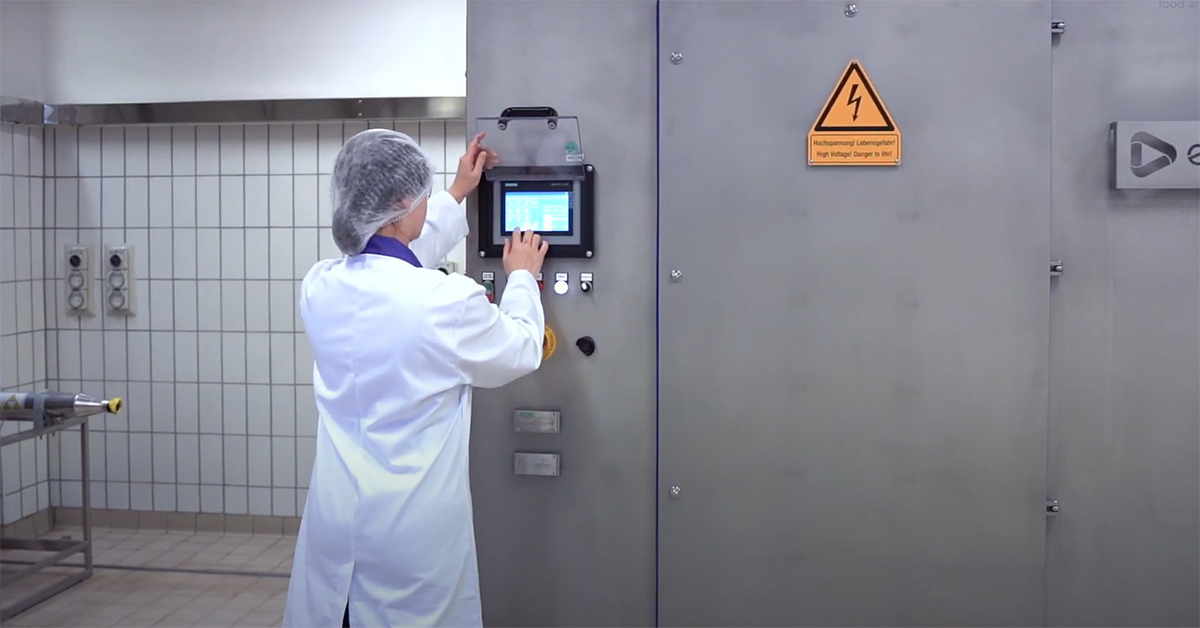
Achieving sustainability and efficiency through new technologies
29 November 2023 | Danny Bayliss, New Technology Lead
Food processing activities – whether harvesting, cleaning, sorting, grinding, mixing, preserving or packaging – all come with a cost, in the form of emissions and the use of energy, water and / or chemicals.
There are, however, a number of food processing technologies that can improve the efficiency and sustainability of many different food processing activities. Such as using electrification technology for heating or using UV-C to decontaminate surfaces.
This blog explores both of these examples, among other ways that new processing technologies can be used to make food and beverage production more efficient and sustainable.
Germicidal UV-C applications – reducing the use of water, chemicals and energy
UV-C can be used for a range of food and drink industry applications, namely for decontamination of liquids and the surface of solids.
Here are some of the applications and their associated benefits compared to the use of more traditional / typical technologies for this food processing activity:
- Decontamination of the surface of food crops – decrease the need for pesticides.
- Water / beverage treatment – Non-thermal to protect nutrients in foods and maintaining water quality without chemicals for in factory use.
- Decontamination of the surface of food packaging – reduced chemical / water usage.
- Decontamination of the surface of basic foodstuff – as an alternative to preprocess washing (i.e. reduced energy / chemical / water usage) and as a shelf-life extension strategy.
One example of where this final application could be used is within wash tunnels / chemical spray tunnels, which use large quantities of water. The negative sustainability impact is heightened by the need to heat up the liquid and the use of sanitising chemicals as the decontaminating agent.
The use of UV-C as an alternative method for the decontamination (i.e. conveyoring the food or equipment for decontamination through a UV-C tunnel instead of a wash tunnel) can therefore reduce the chemical and water usage associated with this processing step.
Trials at our facility indicate good log reductions for relatively low dosages, and these reductions can be greater than from some wash tunnel systems depending how they are operated.

When comparing the energy consumption of our UVC tunnel to a 1 horsepower pump (which may be used for the spray nozzles in a wash tunnel; the lowest power pump typically used), the energy usage was comparable (comparisons of other UVC and wash tunnel systems with each other will depend on the size of the pumps used in the wash tunnel system and the number of motors and dose / number of lamps in the UVC system). If a greater power pump is used or the pump is not running efficiently then UVC tunnels may also save manufacturers energy.
UV-C can also use less electricity than a wash tunnel, whilst receiving the same log reduction. These savings could have a substantial impact given the many different ingredients, intermediates and food products, and associated production equipment, that are transferred through wash tunnels throughout food processing and production facilities.
UV-C therefore presents a cost-saving and sustainability opportunity for food business operators.
Electrification processing technologies – reducing CO2 emissions
When it comes to high energy demand processes, such as those that involve heating and cooling, how can companies move away from heavy CO2 emitting processes like natural gas boilers?
The vast majority of food and drink manufacturers will have a gas boiler to generate hot water or steam for heating applications, such as thermal processing. The energy efficiency of heating this water via a centralised source, then using it to heat the food product, comes with efficiency challenges and emissions considerations.
One area of focus is electrification processing technologies, where food business operators can lock in renewable deals or have their own site generation of renewable energy in order to benefit more heavily from electrified processes. Here we explore a few examples of these electrified processes, and how they can be applied to improve sustainability of thermal processing and other food processing activities.
Induction heating is a promising technology that can reduce emissions (subject to how the electricity used is generated). With up to 90-95% of the energy directly transmitted to the liquid being heated by induction heating, this technology can improve efficiency as well as reduce greenhouse gas emissions.
Applications include trim heating, kettle boosting and CIP (cleaning in place), as well as the heating of any liquid product for hot fill, UHT, or pasteurisation, such as beverages, purees, sauces, stocks, bases and oils.
Similar to the induction hobs used domestically, induction heating technology uses a wound metal coil, which is electrically powered, and a heated metal element, which then heats the product. Industrial processing with induction heating involves the powered coil being wrapped around a pipe with the flowing liquid inside. The induction coil heats the heating applicator (the element inside the pipe), which heats the liquid in the pipe. The heating applicator also acts as a mixing device to ensure consistent heating, and can have greater surface area to improve the heat transfer.
The improved heating efficiency can reduce start up times and shorten the length of the heating zone, which can reduce waste during operations on start up or recovery from stoppages. The fast electrical responses allow tighter temperature tolerances to be maintained – this could lower manufacturers’ target temperatures, because these are typically set higher with steam-based systems which can be slower to respond.
Ohmic heating is used for thermal processing by applying electricity to a product as it passes through two electrodes, which causes resistive heating of the product (the resistance of the product to the current causes it to heat up). Ohmic heating can be very energy efficient, with more than 95% of the applied electrical power being converted to useful heat.
This technology is particularly beneficial for large food pieces in a liquid which need to be heated together in a continuous flow. In a scraped surface heat exchanger, adequate processing of the particulates is typically achieved by an overprocessing of the liquid component (in order to achieve the right temperature within the particulates). Ohmic heating overcomes this, as it can heat particulates in liquid at the same rate as the liquid itself, therefore reducing overprocessing of the liquid.
Radio Frequency and Microwave technologies are already being used for blanching, thawing, tempering, drying and pasteurising processes, and new applications are emerging for continuous processing of liquids (which are particularly beneficial for liquids that contain particulates – typically a challenge in thermal processing of liquids).
The technology works by electric dipole (a partial positive and negative charge at opposite ends, like water for example) particles within food trying to align with the electric fields generated by the radio frequency waves or microwaves. This tendency for alignment causes oscillation and rotation of these particles. The electromagnetic energy absorbed by these particles causes them to collide with other particles, dispersing energy and leading to temperature increases in the food.
Applying this to continuous processing of a liquid with particulates means there are no hot surfaces heating the product, which can reduce fouling. The penetration of the electromagnetic energy into the product can also allow volumetric heating of liquids and particulates, which can also reduce overprocessing. Maintaining uniformity of heating can be a challenge, but ensuring correct mixing can help limit this.
Radio Frequency and Microwave technologies are more influenced by the dielectric properties of the food product being processed, whereas ohmic heating technology is influenced by conductivity. Therefore radio frequency and microwave technologies could be a suitable electrified heating option for products that are not suitable for ohmic processes.
PEF and CFIT – improving efficiency and removing processing steps
Improving the efficiency of processing steps (such as through applying pulsed electric field technology), or even being able to remove whole processing steps entirely (see the homogenisation technology example below), can be a great way to improve the overall efficiency and sustainability of your operation.
Pulsed Electric Field (PEF) processing is an electric powered method that punches holes in cells as they pass through a pair of electrodes, which are applying high voltage pulses. The applied power and specific energy delivered can be tailored for different applications, many of which can have an impact on sustainability.
PEF can be used to improve efficiency, quality and yield in extraction processes, cutting and slicing, freeze-drying, brining, ripening and grain steeping. Its use has shown significant uptake for improving yields in extraction applications and has been widely used in the snacking industry to soften vegetable tissues.
Counter flow injection technology (CFIT) can be used to improve the efficiency and sustainability of homogenisation.
Many processes and products require emulsification of different liquid phases, such as oil, and an aqueous phase, such as water. In order for the emulsion to be stable over the intended shelf-life of a food or beverage, small, uniform droplet sizes are required. Commercially, manufacturers will form a pre-emulsion of larger droplet sizes then further emulsify with a single or multistage homogenisation process (using, for high pressure homogenisation, colloid milling, rotor-stator or rotor-rotor systems, ultrasonic or membranes).
CFIT is a direct method of homogenisation by injecting the two phases into a collision chamber without pre-emulsion. It therefore removes the need for a pre-emulsion, and the energy usage that would otherwise be associated with this processing step.
Optimise now for a sustainable and profitable future
It is likely that, since initially developing your product, new and improved technologies now exist that may significantly improve your manufacturing process.
Existing and emerging processing technologies can be used to optimise costs, improve efficiency and sustainability of processing, and improve quality of food and beverage products. By adopting advanced technologies and best practices, you can benefit from reduced waste and increased productivity, create new revenue streams, and unlock elusive value and potential from your products.
Get in touch if you would like to know more about any of these technologies with respect to your operation.

About Danny Bayliss
After finishing his PhD in cold plasma technology, Danny joined Campden BRI where he has been in various new technology roles since 2012. Danny currently explores future trends and technology developments where he works with spin off, startups and equipment companies to explore commercial applications or develop technologies for industrial future needs. Danny manages more complex contract trials and works on bigger research projects with multiple consortium members.
How can we help you?
If you’d like to find out more about making your products and processes more sustainable, contact our support team to find out how we can help.
Find out more
For more on applications of new technologies and what we offer, view our new technologies services.







